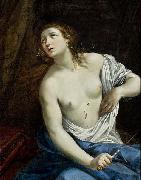
Oil On
Canvas, Real Flavor of Old Masters
|
Albrecht Durer
|
|||
|
|
|||
| b.May 21, 1471, Imperial Free City of Nernberg [Germany] d.April 6, 1528, Nernberg Albrecht Durer (May 21, 1471 ?C April 6, 1528) was a German painter, printmaker and theorist from Nuremberg. His still-famous works include the Apocalypse woodcuts, Knight, Death, and the Devil (1513), Saint Jerome in his Study (1514) and Melencolia I (1514), which has been the subject of extensive analysis and interpretation. His watercolours mark him as one of the first European landscape artists, while his ambitious woodcuts revolutionized the potential of that medium. D??rer introduction of classical motifs into Northern art, through his knowledge of Italian artists and German humanists, have secured his reputation as one of the most important figures of the Northern Renaissance. This is reinforced by his theoretical treatise which involve principles of mathematics, perspective and ideal proportions. His prints established his reputation across Europe when he was still in his twenties, and he has been conventionally regarded as the greatest artist of the Renaissance in Northern Europe ever since. | |||
|
|
|||
|
|
The Suicide of Lucretia new16/Albrecht Durer-494433.jpg Painting ID:: 42357 Visit European Gallery |
mk168 168x75cm | |
Height Width |
INS/CM |
||
|
X |
|
||
|
|
|||
|
Workshop of Anton von Maron
|
|||
|
|
|||
| Anton von Maron (January 8, 1733 - March 3, 1808) was an Austrian painter, active in Rome. Von Maron was born in Vienna, but moved at a young age to Rome. There, he studied under Anton Raphael Mengs, and became an accomplished portrait painter. He married a sister of Mengs, Therese Maron, who was a painter in her own right. He lived the rest of his life in Rome, and died there in 1808. | |||
|
|
|||
|
|
The Suicide of Lucretia new25/Workshop of Anton von Maron-968847.jpg Painting ID:: 84628 Visit European Gallery |
Oil on canvas Dimensions 113 x 91 cm (44.5 x 35.8 in) cyf | |
Height Width |
INS/CM |
||
|
X |
|
||
|
|
|||








